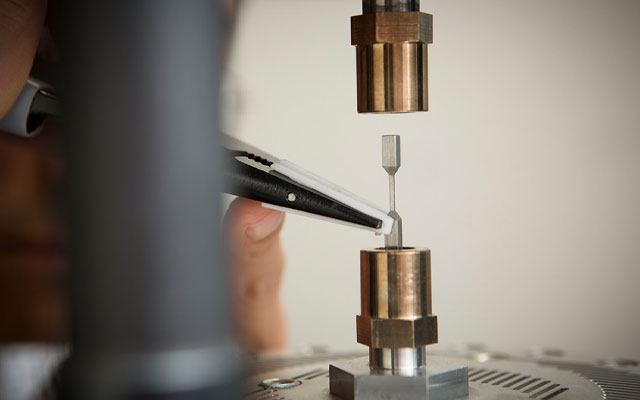By Kimberly Mann Bruch, SDSC Communications
The National Science Foundation (NSF) recently awarded a $1 million Research Advanced by Interdisciplinary Science and Engineering (RAISE) grant to a multidisciplinary team of researchers at the San Diego Supercomputer Center (SDSC) at the University of California San Diego, the University of Minnesota, Carnegie Mellon University, and Cornell University to create the X-ray Imaging of Microstructures Gateway (XIMG), a science gateway designed to make it possible for global material sciences researchers to study the behavior of new and existing materials using X-ray diffraction.
The XIMG Science Gateway will be an online resource that provides researchers everywhere with tools to examine high energy X-ray data collected from beamlines at the Cornell High Energy Synchrotron Source (CHESS) as well as other synchrotrons around the world. A single experiment at CHESS using high energy x-rays generates Terabytes of high-fidelity scattering data and XIMG (pronounced X-image) will provide tools to examine these large datasets in the presence of software and compute power available through the NSF-funded Expanse and Comet supercomputers at SDSC. This will allow scientists and engineers to analyze data that are currently difficult or impossible to access on-line.
Science gateways make it possible to run available applications on supercomputers such as SDSC’s Comet system, allowing researchers to focus on their scientific problems without having to learn the details of how supercomputers work.
Over the past decade, CHESS and several other high-energy synchrotrons around the world have developed cutting edge techniques to use spatially resolved X-ray diffraction to characterize important structural materials. These materials, such as steel, titanium, and aluminum alloys, are used in almost every important load-bearing application. When analyzed by high-performance supercomputers, the large X-ray diffraction data sets collected at high intensity x-ray ources reveal how the three-dimensional microstructure of complex materials behaves under stress, where reliability, sustainability, and durability are key. Ultimately, the data gathered and analyzed using XIMG will make it possible to predict the properties of next-generation devices and materials using computer-aided design.
The XIMG will be developed by a multi-institutional team led by Principal Investigator (PI) Jorge Vinals of the University of Minnesota, Professor Matthew Miller at Cornell University, Professor Robert Suter of Carnegie Mellon University, and Dr. Mark Miller, a biologist at SDSC and PI of the NSF-funded CyberInfrastructure for Phylogenetic RESearch (CIPRES) gateway. The project will include domain colleagues and software developers from all four institutions.
“Merging this high-fidelity X-ray data from CHESS with the most current generation of structural material models can change the way new alloys and new engineering components are constructed and designed with those alloys,” said co-PI Matt Miller at Cornell. “We are excited for the accessibility this will create for researchers in the broader materials science community.”
“The XIMG will be the first of its kind for the materials science community where toolkits are available for visualization, modeling, and simulation at mesoscale and nanoscale levels,” said Mark Miller. “Providing public access to these resources will not only make it easier to use existing tools to analyze synchrotron data, it will also make it easier to develop and benchmark new tools, and distribute and test new tools within the community.”
The NSF RAISE program supports lines of research that promise transformational advances through prospective discoveries that reside at the interfaces of disciplinary boundaries and can be outside the scope of a single NSF program, according to the federal agency. The XIMG award, (NSF OAC 2037773), runs from August 1, 2020 through July 31, 2022 (estimated). The award abstract can be found here.
About SDSC
The San Diego Supercomputer Center (SDSC) is a leader and pioneer in high-performance and data-intensive computing, providing cyberinfrastructure resources, services, and expertise to the national research community, academia, and industry. Located on the UC San Diego campus, SDSC supports hundreds of multidisciplinary programs spanning a wide variety of domains, from astrophysics and earth sciences to disease research and drug discovery. In late 2020 SDSC will launch its newest National Science Foundation-funded supercomputer, Expanse. At over twice the performance of Comet, Expanse supports SDSC’s theme of ‘Computing without Boundaries’ with a data-centric architecture, public cloud integration, and state-of-the art GPUs for incorporating experimental facilities and edge computing.
About the University of Minnesota
The flagship University of Minnesota Twin Cities is the state’s land-grant university and one of the most prestigious public research universities in the nation. It is home to the NSF Materials Research Science and Engineering Centers (MRSEC) program, which provides sustained support of interdisciplinary materials research and education of the highest quality.
About CHESS
The Cornell High Energy Synchrotron Source, CHESS, is a high-intensity X-ray source primarily supported by the NSF which provides users with state-of-the-art synchrotron radiation facilities for research in physics, chemistry, biology, and environmental and materials sciences.


